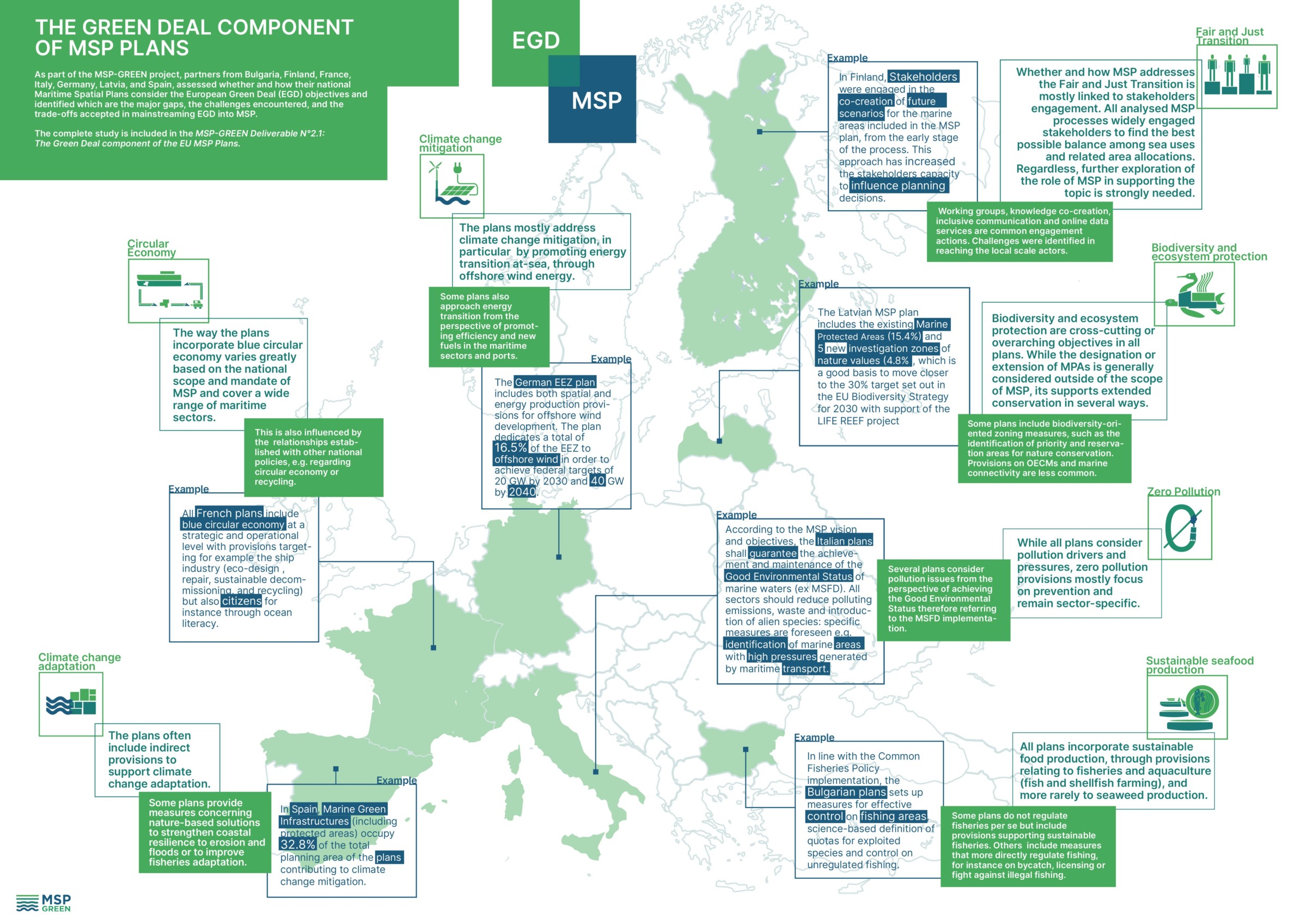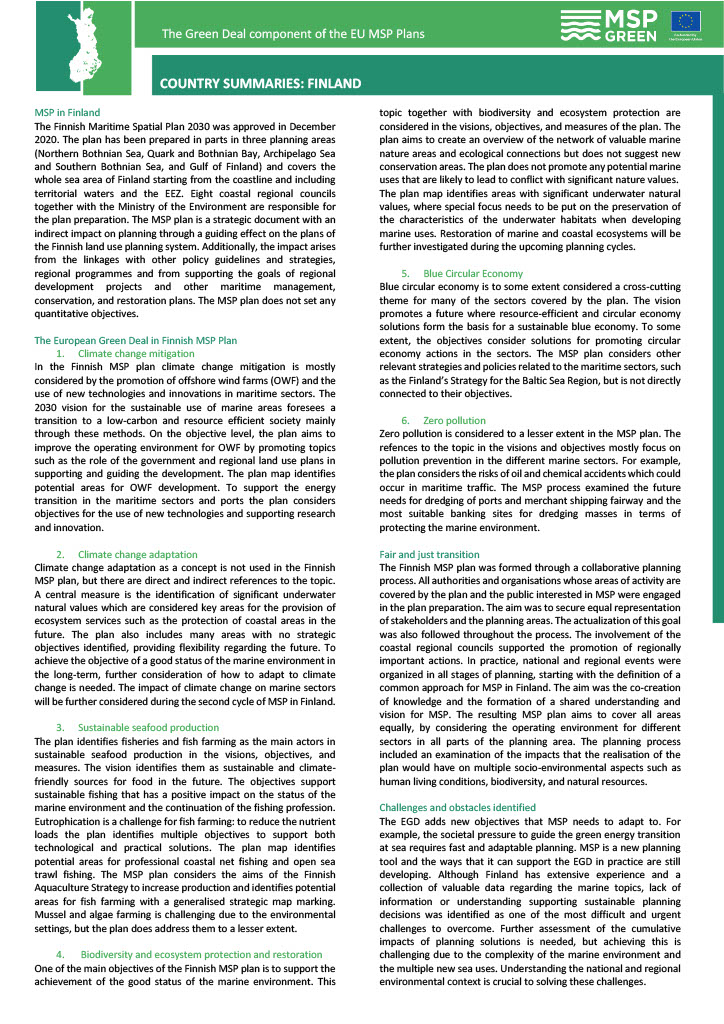The green transition in Finnish marine areas
When talking about the green transition, the focus is often on the production of zero-emission energy and the achievement of conservation objectives in marine areas. In addition to these topics, several other themes are considered under the European Green Deal, which all are connected to the green transition. New marine uses and changes in the marine environment will have an impact on marine areas. Maritime spatial planning is an important planning tool for the promotion of green deal objectives in the marine realm. In this work, coordination different interests, multi-use of marine areas, participation and equity are key topics to consider.
So what are we talking about when we talk about the European Green Deal and the green transition in marine areas?
”The rapid development of offshore wind energy in the Gulf of Bothnia has directed the focus to climate change mitigation,” says Mari Pohja-Mykrä, coordinator of the Maritime Spatial Planning cooperation in Finland. ”In marine areas, carbon-neutral energy production and new low-carbon technologies are contributing to the green transition. In addition to this, sustainable sea-food production and the protection of marine biodiversity and ecosystems are key topics that are also broadly considered in the current Maritime Spatial Plan for Finland 2030. These issues are very topical due to the new objectives for and the on-going changes taking place in marine areas”, says Pohja-Mykrä.
Ecosystem restoration, climate change adaptation, blue circular economy and zero pollution have so far received less attention in maritime spatial planning. Despite the reduction in climate emissions, we need to form a long-term perspective on how different sectors and marine nature will adapt to a changing climate. Promoting the development of resource-efficient and circular economy solutions and waste prevention will contribute to the objective of promoting sustainable blue economy. Pollution is a global crisis alongside climate change and natural degradation. In Finland, cooperation with the management of water resources and marine environments plays a key role in promoting zero pollution.
”A built-in element of the European Green Deal is the promotion of a fair and just green transition”, recalls Vesa Arki, project planner of the MSP-GREEN project. ”Maritime spatial planning is an inclusive process that seeks to engage the marine stakeholders in an open, timely and equitable manner. The aim is to provide a genuine opportunity to influence the outcome of the planning process or in other words the maritime spatial plan. The planning process must consider the conflicts that might arise in the coordination of different marine activities and the fair distribution of costs and benefits,” says Arki.
The text above described seven key themes of the European Green Deal relevant for the marine realm. These themes were identified by the MSP-GREEN project. The work assessed how these themes are considered in the Maritime Spatial Plan of Finland 2030 and how they could be promoted through maritime spatial planning in the future.

The MSP-GREEN -project analyzed how the maritime spatial plans of seven EU Member States have considered the European Green Deal themes. Click on the image to see examples of maritime spatial plans from the different countries. Graphics by Università Iuav di Venezia.
- Climate change mitigation – The EU’s goal is to achieve carbon neutrality by 2050. Finland has set a similar target for 2035. In the Finnish maritime spatial plan, the main ways to support the achievement of this objective include promoting offshore wind energy development and identifying potential energy production areas, exploiting new low-carbon technologies and innovations in maritime sectors, and protecting and restoring valuable carbon sinks in marine areas.
- Climate change adaptation – Adaptation actions are based on anticipating the future of marine areas and developing a holistic view of the impacts of climate change on marine nature and the marine sectors. The concept of adaptation is not used in the Maritime spatial plan of Finland 2030, but the topic is addressed to some extent. A key measure is the identification of important underwater nature values, which are important areas for the provision of ecosystem services.
- Sustainable sea-food production – Fisheries and fish farming are the basis for sustainable sea-food production. In the maritime spatial plan, the focus is on safeguarding key fishing areas and fish stocks, including fish spawning grounds, minimizing environmental impacts of the actions, identifying areas with potential for fish farming production and addressing nutrient loading. Algae and shellfish farming provide an opportunity to remove nutrients from the sea.
- Biodiversity and ecosystem protection and restoration – The EU Biodiversity Strategy aims to protect at least 30% of marine areas, with 10% of these areas under strict protection. The aim is also to restore degraded ecosystems. The maritime spatial plan does not propose or identify new protected areas, but the existing protected areas have been considered in the planning solutions. The objective of the maritime spatial plan is to provide an overview of the network of valuable marine habitats and ecological connectivity and thus of marine ecosystem services in general.
- Blue circular economy – Resource-efficient and circular economy solutions and waste prevention contribute to a sustainable blue economy, where natural resources are used more sustainably and remain in circulation longer. The maritime spatial plan promotes the use of new technologies and innovations in maritime transport, maritime industries, and ports, as well as waste collection and recycling.
- Zero pollution – The promotion of pollution prevention is a cross-cutting theme regarding all marine sectors. The reduction of pollutants discharged into the sea from marine and coastal activities and the rehabilitation of contaminated or littered sites are key issues to consider. The maritime spatial plan has a limited focus on pollution prevention. The link with water and marine management is central to the promotion of these objectives.
- Fair and just transition – A fair and just transition towards a low carbon society will treat everyone equally. Among other things, equitable access for stakeholders and regions to influence decision-making and a fair distribution of costs and benefits are key elements in promoting a just transition. Finland’s Maritime spatial plan 2030 was prepared in a collaborative and inclusive planning process. The aim was to build a common understanding of the needs and development objectives of the marine sectors and to formulate a common vision for the marine areas. As coastal regional councils are responsible for maritime spatial planning, they were able to promote activities of regional importance.

How are the European Green Deal themes considered in Finland’s Maritime spatial plan 2030? Click on the image to see a summary of the results.
The Green Deal component of the EU MSP Plans -report examines how the maritime spatial plans of seven EU Member States have considered the objectives of the European Green Deal. You can find the full report here. The work has been carried out as part of the MSP-GREEN project, funded by the European Maritime, Fisheries and Aquaculture Fund. The project will run from November 2022 to October 2024.
Project website: https://mspgreen.it/
Twitter: @MSPGREEN22 & LinkedIn: MSP – GREEN





